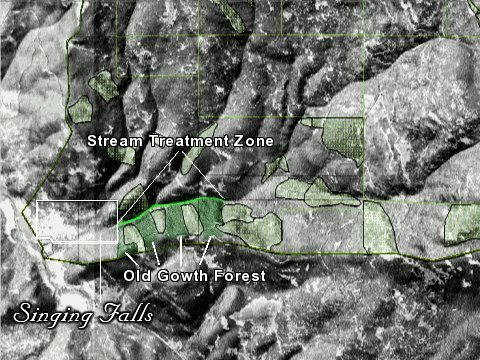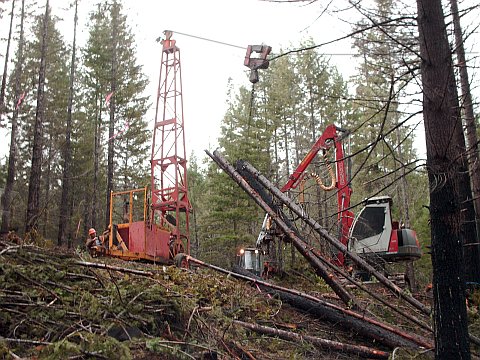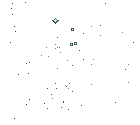~~* The Singing Falls Stream Restoration Project *~~
 ϕ
ϕ
~~* Project Implementation Phase-LWD Using a “High Line” Yarder *~~
Image Gallery Link Located Below Text
Aquatic Habitat Restoration-Cultivating the Domestic/Wilderness Interface
The upper end of Joe Hall Creek is located in a mix of National Forest lands and private timber company lands. The topography is relatively flat but the surrounding uplands are very steep. The area of treatment contains a very old population of resident Cutthroat trout. This section of the stream is being treated to enhance the already wild and wooly habitat. Some sections of the stream have natural log weirs and old woody debris is place already. The 3D image below illustrates the stream treatment area. The sections of the forest between the old growth had been clear cut during the 1980's before the spotted owl was discovered to be endangered species.

Dark green areas designate areas of old growth timber in the national forest along the upper Joe Hall Creek stream restoration treatment area.
As such this drainage contains stretches of stream that have been minimally impacted by modern logging. The area was regularly purged by low intensity fires to clear underbrush such as poison oak and vine maple. We greatly enjoy canvasing the riparian zone on foot to experience what our Native American brothers saw and touched. Not very much of this type of terrain remains for us. The demands for the ever expanding growth of society places such ecological zones in jeopardy and they dearly need to be protected. The wilderness like character of this portion of Joe Hall Creek makes it an excellent candidate for light touch efforts to restore ideal rearing habitat for the South Umpqua Cutthroat trout.
The logging equipment often used to extract wood from such steep topological climbs is called a “Cable Yarder” or “Yarder” for short. This type of equipment was perfect for the restoration work desired here. Young strong men are required to handle the long stretch of cable pulled from the tower located high up on the ridge. A rigging of pullies, chokers and tail hold straps are used to negotiate the log placement. Communication is maintained via a radio system since the yarder operator has no visual contact with the job site. He operates in the blind. His crew far below are his eyes and ears. It is dangerous work and requires team work and fine tuned skill sets.
The image gallery contains photos showing how the stream was impacted by the log placement. Downed old growth timbers along the riparian zone were gently tugged into the stream channel. After having traversed that stretch of the stream I was impressed with the natural character of the treatment. This was a great enhancement for restoration that has the potential of doubling the rearing habitat for Cutthroat, Steelhead and Coho in this stream. Only time will tell. Nature has to do the rest.
Click on the link to access the gallery.
| High Line Yarder Based Large Wood Placement Image Gallery | Free Restoration Guidelines |

A “Yarder” hauling small diameter wood
top






